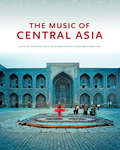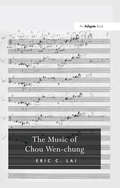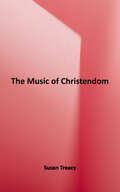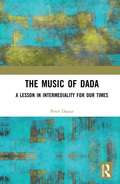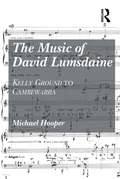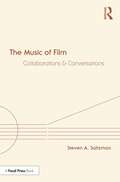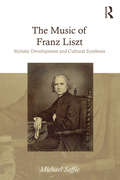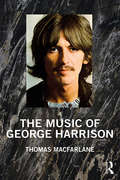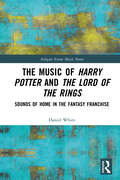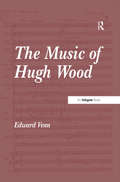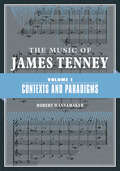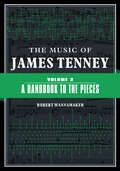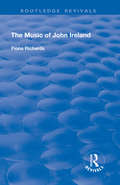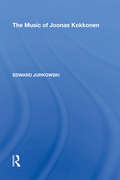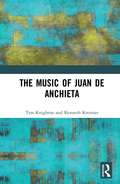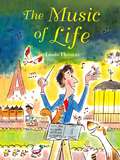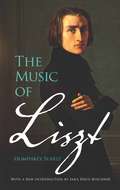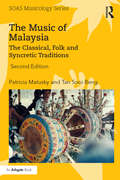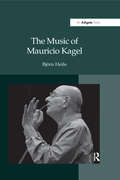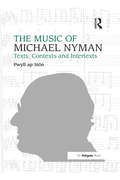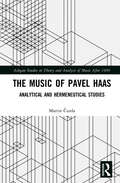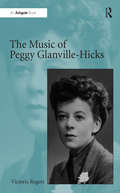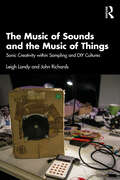- Table View
- List View
The Music of Central Asia
by Theodore LevinThis beautiful and informative enhanced ebook—so comprehensive it had to be split into two volumes, ebook 1 and ebook 2—offers a detailed introduction to the musical heritage of Central Asia for readers and listeners worldwide. Music of Central Asia balances "insider" and "outsider" perspectives with contributions by 27 authors from 14 countries. This stunning electronic book allows readers the opportunity to deeply engage with source material through over 180 embedded audio and video, pop-up study questions, transliterations and translations of performed texts, and direct links to the companion website (www.musicofcentralasia.org). The audio and video examples include transliterations and translations of the performed texts and a follow-along feature highlights the song lyrics in the text, as the audio samples play. This generously illustrated book is supplemented with boxes and sidebars, musician profiles, and an illustrated glossary of musical instruments, making it an indispensable resource for both general readers and specialists.Ebook 1 includes part I, "Music and Culture in Central Asia," an introductory overview of the music and musical instruments of Central Asia, and part II, "The Nomadic World," which focuses on music and musical life in historically nomadic regions of Central Asia. Ebook 2 contains part III, "The World of Sedentary Dwellers," which focuses on music and musical life in historically settled regions of Central Asia, and part IV, "Central Asian Music in the Age of Globalization," which addresses "the future of the past," focusing on cultural revitalization and renewal, tradition-based popular music, and contemporary music inspired but not constrained by tradition.
The Music of Chou Wen-chung
by EricC. LaiChou Wen-chung is one of the most influential musical figures of our time. His rich cultural background, his studies with Edgard Var and his interest in the genuine rapport between Eastern and Western musical traditions have been the major influences on his career. Although he is active in various artistic and cultural circles that include scholarship, education and cultural preservation, his major calling has always been composition. As a composer, Chou has created a group of works whose stylistic innovation and technical profundity are distinctive among composers of his generation. His music, which has received critical acclaim around the globe, documents his creative journey, especially in the realization of re-merger - the fusion of Eastern and Western music that has become a new mainstream in art music. Through extensive focus on sketch study, Eric Lai examines Chou's music to contribute to an understanding of his aesthetic orientation, his compositional technique, his role in the development of new music, and his influence upon the younger generation of composers.
The Music of Christendom: A History
by Susan TreacyMusic plays such an important part in everyone's life but how much do we know about the history of music? How did music shape our civilization and how was music itself shaped by the Catholic Church? Susan Treacy, an experienced professor of music, is an excellent guide to the history of music. Every Catholic should own at least one book on music. This is it.
The Music of Dada: A lesson in intermediality for our times
by Peter Dayan100 years after the Dada soirées rocked the art world, the author investigates the role that music played in the movement. Dada is generally thought of as noisy and unmusical, but The Music of Dada shows that music was at the core of Dada theory and practice. Music (by Schoenberg, Satie and many others) performed on the piano played a central role in the soirées, from the beginnings in Zurich, in 1916, to the end in Paris and Holland, seven years later. The Music of Dada provides a historical analysis of music at Dada events, and asks why accounts of Dada have so consistently ignored music’s vital presence. The answer to that question turns out to explain how music has related to the other arts ever since the days of Dada. The music of Dada is the key to understanding intermediality in our time.
The Music of David Lumsdaine: Kelly Ground to Cambewarra
by Michael HooperAustralian by birth but a longtime resident of Great Britain, David Lumsdaine (b.1931) is central to both Australian and British modernism. During the early 1970s Australian musical modernism was at its height. Lumsdaine and his Australian contemporaries were engaged with practices from multiple places, producing music that displays the attributes of their disparate influences; in so doing they formed a new conception of what it meant to be an Australian composer. The period is similarly important in Britain, for it saw the rise to prominence of composers such as Birtwistle, Davies, Goehr, Gilbert, Wood, Cardew and many others who were Lumsdaine's contemporaries, colleagues and friends. Hooper presents here a series of analyses of Lumsdaine's compositions, focusing on works written between 1966 and 1980. At the early end of this period is Kelly Ground, for solo piano. One of Lumsdaine's first acknowledged works, Kelly Ground connects explicitly with the music of high modernism, employing ideas about temporality as espoused by Ligeti, Stockhausen and Boulez, to form a new ritual for the (now mythical) Australian outlaw Ned Kelly. Hooper places Lumsdaine's music in the context of Australian and British avant-gardes, and reveals its elegance, lyricism and technical virtuosity.
The Music of Film: Collaborations and Conversations
by Steven A. SaltzmanThe Music of Film opens up the world of film music from the inside. Through a series of interviews and conversations with professional composers, music supervisors, music editors, and picture editors, this book shows how music for film and television works according to insiders in the industry. Here we find a comprehensive collection of techniques and personal insights and get a unique perspective on how these key players in postproduction interact, collaborate, and successfully build their careers. The Music of Film is essential reading for composers, editors, directors, and producers—aspiring and established alike—or anyone interested in learning how to start or manage a profession working with music in feature films, television, and other media.
The Music of Franz Liszt: Stylistic Development and Cultural Synthesis
by Michael SaffleMuch of Franz Liszt's musical legacy has often been dismissed as 'trivial’ or 'merely showy,' more or less peripheral contributions to nineteenth-century European culture. But Liszt was a mainstream composer in ways most of his critics have failed to acknowledge; he was also an incessant and often extremely successful innovator. Liszt's mastery of fantasy and sonata traditions, his painstaking settings of texts ranging from erotic verse to portions of the Catholic liturgy, and the remarkable self-awareness he demonstrated even in many of his most 'entertaining' pieces: all these things stamp him not only as a master of Romanticism and an early Impressionist, but as a precursor of Postmodern 'pop.' Liszt's Music places Liszt in historical and cultural focus. At the same time, it examines his principal contributions to musical literature -- from his earliest operatic paraphrases to his final explorations of harmonic and formal possibilities. Liszt's compositional methods, including his penchant for revision, problems associated with early editions of some of his works, and certain aspects of class and gender issues are also discussed. The first book-length assessment of Liszt as composer since Humphrey Searle’s 1956 volume, Liszt's Music is illustrated with well over 100 musical examples.
The Music of George Harrison
by Thomas MacFarlaneGeorge Harrison was one of the most prolific popular music composers of the late 20th century. During his tenure with the Beatles, he caught the wave of 1960s pop culture and began channeling its pervasive influence through his music. Often described as "The Invisible Singer," his solo recordings reveal him to be an elusive, yet essential, element in the Beatles’ sound. The discussion of George Harrison’s Beatle tracks featured in the text employs a Songscape approach that blends accessible music analysis with an exploration of the virtual space created on the sound recording. This approach is then used to explore Harrison’s extensive catalog of solo works, which, due to their varied cultural sources, seem increasingly like early examples of Global Pop. In that sense, the music of George Harrison may ultimately be viewed as an important locus for pan-cultural influence in the 20th century, making this book essential reading for those interested in the history of songwriting and recording as well as the cultural study of popular music.
The Music of Harry Potter and The Lord of the Rings: Sounds of Home in the Fantasy Franchise (Ashgate Screen Music Series)
by Daniel WhiteThe Music of Harry Potter and The Lord of the Rings provides an in-depth study of the music of two of the biggest fantasy franchises, focussing on music’s worldbuilding roles within the film-watching experience and elsewhere in videogames, trailers, plays, theme parks and other attractions, and the world of fandom.Daniel White takes a range of approaches and techniques of motivic and thematic musical analysis, and pairs this with transformational harmonic analysis to theorise music’s worldbuilding roles in film. Chapters focus in turn on the opening sequences of the case study franchise films, their closing sequences, and on their depiction of houses, homes and homelands. Extra-filmic areas of these fantasy worlds are also explored, including theme parks and other tourist attractions of the Harry Potter franchise, videogames and the immersive power of their music, and the world of fandom with a focus on soundtrack consumption and other musical fan practices. Through this multifaceted approach, readers gain a deeper understanding not only of the music of these franchises, but also of music’s power in the multimedia franchise both within and without film to build a home that attracts inhabitants. This book will be valuable for academics and students as well as fans of fantasy franchises.
The Music of Hugh Wood
by Edward VennThe Music of Hugh Wood provides the first ever in-depth study of this well-known, yet only briefly documented composer. Over the years, Wood (b. 1932) has produced a sizeable oeuvre that explores the established genres of symphony, concerto, and quartet on the one hand, and songs and choruses on the other. Underpinned by an awareness of recent philosophical, theoretical and analytical concepts, Dr Edward Venn highlights both the technical basis of Wood's music and the expressive force of his work. In doing so, a picture emerges of Wood as an artist of considerable merit and power. The eclectic blend of national and international influences in the music of Hugh Wood combine to create an individual and distinctive musical language all his own. The book provides an overview of Wood's style, focussing on his engagement with modernism and the melodic, rhythmic, harmonic and formal characteristics of his musical language. From here a more detailed consideration of Wood's development as a composer is advanced, in which his technical development is illustrated alongside an exploration of various aspects of musical meaning embodied in his works. In the process, numerous analytical strategies ranging from formalist to narrative structures are utilized, demonstrating the fecundity and expressivity of Wood's music.
The Music of James Tenney: Volume 1: Contexts and Paradigms
by Robert WannamakerParsing the works of the experimental music pioneer Robert Wannamaker's monumental two-volume study explores the influential music and ideas of American composer, theorist, writer, performer, and educator James Tenney. Delving into the whole of Tenney's far-ranging oeuvre, Wannamaker provides in-depth, aurally grounded analyses of works linked to the artist's revolutionary theories of musical form, timbre, and harmonic perception. Volume 1, Contexts and Paradigms, chronologically surveys Tenney's creative development and output. Wannamaker begins each section with biographical, aesthetic, and technical context that illuminates a distinct period in Tenney's career. From there, he analyzes a small number of pieces that illuminate the concerns, characteristics, and techniques that emerged in Tenney's music during that time. Wannamaker supplements the text with musical examples, graphs, and diagrams while also drawing on unpublished material and newly available primary sources to flesh out each work and the ideas that shaped it. A landmark in experimental music scholarship, The Music of James Tenney is a first-of-its-kind consideration of the experimental music titan and his work.
The Music of James Tenney: Volume 2: A Handbook to the Pieces
by Robert WannamakerA work-by-work guide to the composer's groundbreaking music Robert Wannamaker's monumental two-volume study explores the influential music and ideas of American composer, theorist, writer, performer, and educator James Tenney. Delving into the whole of Tenney's far-ranging oeuvre, Wannamaker offers close, aurally grounded analyses of works linked to the artist's revolutionary theories of musical form, timbre, and harmonic perception. Written as a reference work, Volume 2, A Handbook to the Pieces, presents detailed entries on Tenney's significant post-1959 experimental works (excepting pieces covered in volume 1). Wannamaker includes technical information, an analysis of intentions and goals, graphs and musical examples, historical and biographical context, and thoughts from Tenney and others on specific works. Throughout, he discusses the striking compositional ideas found in Tenney's music and, where appropriate, traces an idea's appearance from one piece to the next to reveal the evolution of the composer's art and thought. A landmark in experimental music scholarship, The Music of James Tenney is a first-of-its-kind consideration of the experimental music titan and his work.
The Music of John Ireland
by Fiona RichardsThis title was first published in 2000. John Ireland (1879-1962) was as elusive as the music that he composed. His music resists easy categorization, in part because it is linked so closely to specific events, places and people in Ireland's personal life. The Music of John Ireland explores the expressive and extramusical qualities of Ireland's compositions and their complex system of personal musical symbols, images and ideas. Fiona Richards interweaves biography and musical analysis in a series of chapters which take their themes from the significant influences in Ireland's life: Anglo-Catholicism, paganism, the countryside, the city, love and war. Ireland emerges as highly individual, struggling with his religious beliefs, his sexuality, and an uncertainty as to his success. His music, often an expression of a state of mind, is given, for the first time, the close investigation that it merits. Ireland preferred to compose on a small scale, showing a masterful command of form and a gift for melody. Richards reveals how the essence of the man shines through in the miniatures that he wrote.
The Music of Joonas Kokkonen
by Edward JurkowskiJoonas Kokkonen (1921-1996) has been one of the most performed Finnish composers during the past 25 years both within Finland and abroad.The author's study of Joonas Kokkonen is the first full-scale account in English. Starting with a brief survey of Finnish music during the 20th century, the book then devotes a separate chapter to each of the major genres in which Kokkonen composed: symphonic, orchestral, vocal, chamber and keyboard. Illustrated with over a hundred music examples, The Music of Joonas Kokkonen seeks to overturn his reputation in some quarters as a conservative, even old fashioned, composer, and argues that Kokkonen created an interesting and refreshing approach to dodecaphonic composition and pitch organization. With a full chronological listing of works and bibliography, this book is the most important reference source to date on Kokkonen and his music." "Book Description: One of the most performed Finnish composers during the last 25 years, Joonas Kokkonen (1921-1996) was also instrumental in the development of the nation's system of music education. In this study,the author (music, U. of Lethbridge, Canada) examines Kokkonen's compositions in each of five major genres: symphonic, orchestral, vocal, chamber, and key
The Music of Juan de Anchieta
by Tess Knighton Kenneth KreitnerThis book explores Juan de Anchieta’s life and his music and, for the first time, presents a critical study of the life and works of a major Spanish composer from the time of Ferdinand and Isabel. A key figure in musical developments in Spain in the decades around 1500, Anchieta served in the Castilian royal chapel for over thirty years, from his appointment in 1489 as a singer in the household of Queen Isabel, and he continued to receive a pension from her grandson, the Emperor Charles V, until his death in 1523. He traveled to Flanders in the service of the Catholic Monarchs’ daughter Juana, and was briefly music master to Charles himself. Anchieta, along with Francisco de Peñalosa, his contemporary in the Aragonese chapel, and a few others, was a key figure in the rise of elaborate written polyphony in the Spain of Josquin’s time. The book brings together two of the leading specialists in Spanish music of the era in order to review and revise the rich biographical material relating to Anchieta’s life, and the historiographical traditions which have dominated its telling. After a biographical overview, the chapters focus on specific genres of his music, sacred and secular, with suggestions as to a possible chronology of his work based on its codicology and style, and consideration of the contexts in which it was conceived and performed. A final chapter summarizes his achievement and his influence in his own time and after his death. As the first comprehensive study of Anchieta’s life and works, The Music of Juan de Anchieta is an essential addition to the history of Spanish music.
The Music of Life
by Louis ThomasFull of joy and discovery, Louis Thomas' The Music of Life is a simple, melodious picture book about finding big inspiration and beauty in the smallest of details.At night when everyone else is asleep, one artist sits awake--pencil in hand, stuck. Lenny is a composer, but this evening, no music floats from his head. Then as night breaks into dawn, Lenny's cat, Pipo, begins lapping milk. Lick lick lick. Birds yawn awake, singing in the trees. Tweet tweet! A bike bell tings on the street below. Suddenly, Lenny notices a rhythm to the world around him. He pulls on his coat and walks through the city to write down every sound he can find. Lenny listens to a gardener, a jogger, a dogwalker, and more neighborhood characters. Finally, the morning's sounds culminate in a sun-dappled symphony that Lenny conducts in the center of the park.
The Music of Liszt
by Humphrey SearleThis is the most authoritative study of Liszt's music, being a survey of his 700 compositions and a review of his place in the history of music.
The Music of Liszt
by Humphrey Searle Sara Davis BuechnerVirtuoso pianist Franz Liszt was a key figure in the evolution of modern music. Most of his 700 compositions, which range from romantic impressionism to daring experimental pieces, were written for the piano. This survey by a well-known British composer and musicologist constitutes the most authoritative English-language study of Liszt's works. "Mr. Searle is himself a composer of progressive outlook and he thus speaks with authority. His book was needed and he has made it a good one," observed the Times (London) Literary Supplement. This classic study surveys the compositions in chronological order and the medium for which they were written. The author examines in detail the most important pieces and fully reviews Liszt's place in history. Subjects include romantic pieces, symphonic poems, songs, symphonies, and other works. A biographical summary illustrates the relationship between significant works and events in the composer's life. Acclaimed by Library Journal as "a balanced, long-overdue treatment," this study is essential for every true Lisztian student.
The Music of Malaysia: The Classical, Folk and Syncretic Traditions (SOAS Musicology Series)
by Patricia Matusky Tan Sooi BengThe Music of Malaysia, first published in Malay in 1997 and followed by an English edition in 2004 is still the only history, appreciation and analysis of Malaysian music in its many and varied forms available in English. The book categorizes the types of music genres found in Malaysian society and provides an overview of the development of music in that country. Analyses of the music are illustrated with many examples transcribed from original field recordings. Genres discussed include theatrical and dance forms, percussion ensembles, vocal and instrumental music and classical music. It is an excellent introduction to and exploration of the country's vibrant musical culture. This new, fully revised and updated edition includes time lines, listening guides and two audio CDs of field recordings that are analysed and discussed in the text.
The Music of Mauricio Kagel
by Bj HeileMauricio Kagel was undoubtedly one of the major figures in the new music of the last fifty years. Growing up in the rich cultural atmosphere of Buenos Aires in the 1940s and '50s, where the writer Jorge Luis Borges was one of his teachers, he became a member of avant-garde circles as well as receiving a rigorous musical education. By 1957 Kagel had acted on the advice of Pierre Boulez to move to Europe to pursue a career as a composer. He quickly established himself at Cologne, the rallying point for young composers at the time, and became one of the leading, if controversial, figures at the famous Darmstadt summer courses. He embraced multiple serialism, aleatory technique and electronics, but he is best known for his pioneering explorations in music theatre, radio play, film and mixed media. Bj rn Heile charts Kagel's compositional development, considering the aesthetic and ideological issues the composer raises in his work. Focusing on Kagel's use of music as a means of intellectual inquiry, Heile shows Kagel to constantly question the nature of music and its role in society. Kagel's broadening of the concept of music to include theatre, film and other media, his disdain for purism as well as his subversive humour and sense of the absurd have challenged reified notions of music and art. Heile considers Kagel's background as Argentine immigrant to Europe (born to Russian-Jewish immigrants to Argentina) to situate the composer's aesthetic. What emerges is the breadth of Kagel's imagination and the multiplicity of contexts he drew from, which were both distinctive and, in the age of pluralist multiculturalism and globalization, exemplary. As Heile demonstrates, it was Kagel's enlarged notion of music as inherently multimedial that may be his most important contribution to new music, and on which his reputation ultimately rests.
The Music of Michael Nyman: Texts, Contexts and Intertexts
by Pwyll ap SiônNyman's rise to international prominence during the last three decades has made him one of the world's most successful living composers. His music has nevertheless been criticized for its parasitic borrowing of other composers' ideas and for its relentless self-borrowing. In this first book-length study in English, Pwyll ap Si laces Nyman's writings within the general context of Anglo-American experimentalism, minimalism and post-minimalism, and provides a series of useful contexts from which controversial aspects of Nyman's musical language can be more clearly understood and appreciated. Drawing upon terms informed by intertextual theory in general, appropriation and borrowing are first introduced within the context of twentieth-century art music and theory. Intertextual concepts are explained and their terms defined before Nyman's musical language is considered in relation to a series of intertextual classifications and types. These types then form the basis of a more in-depth study of his works during the second half of the book, ranging from opera and chamber music to film. Rather than restricting style and technique, Nyman's intertextual approach, on the contrary, is shown to provide his music with an almost infinite amount of variety, flexibility and diversity, and this has been used to illustrate a wide range of technical, aesthetic and expressive forms. He composes with his ear towards the past as if it were a rich quarry to mine, working like a musical archaeologist, uncovering artefacts and chiselling fresh and vibrant sonic edifices out of them.
The Music of Multicultural America: Performance, Identity, and Community in the United States (American Made Music Series)
by Kip Lornell and Anne K. RasmussenThe Music of Multicultural America explores the intersection of performance, identity, and community in a wide range of musical expressions. Fifteen essays explore traditions that range from the Klezmer revival in New York, to Arab music in Detroit, to West Indian steel bands in Brooklyn, to Kathak music and dance in California, to Irish music in Boston, to powwows in the midwestern plains, to Hispanic and Native musics of the Southwest borderlands. Many chapters demonstrate the processes involved in supporting, promoting, and reviving community music. Others highlight the ways in which such American institutions as city festivals or state and national folklife agencies come into play. Thirteen themes and processes outlined in the introduction unify the collection's fifteen case studies and suggest organizing frameworks for student projects. Due to the diversity of music profiled in the book—Mexican mariachi, African American gospel, Asian West Coast jazz, women's punk, French-American Cajun, and Anglo-American sacred harp—and to the methodology of fieldwork, ethnography, and academic activism described by the authors, the book is perfect for courses in ethnomusicology, world music, anthropology, folklore, and American studies. Audio and visual materials that support each chapter are freely available on the ATMuse website, supported by the Archives of Traditional Music at Indiana University.
The Music of Pavel Haas: Analytical and Hermeneutical Studies (Ashgate Studies in Theory and Analysis of Music After 1900)
by Martin ČurdaThe Czech composer Pavel Haas (1899–1944) is commonly positioned in the history of twentieth-century music as a representative of Leoš Janáček’s compositional school and as one of the Jewish composers imprisoned by the Nazis in the concentration camp of Terezín (Theresienstadt). However, the nature of Janáček’s influence remains largely unexplained and the focus on the context of the Holocaust tends to yield a one-sided view of Haas’s oeuvre. The existing scholarship offers limited insight into Haas’s compositional idiom and does not sufficiently explain the composer’s position with respect to broader aesthetic trends and artistic networks in inter-war Czechoslovakia and beyond. This book is the first attempt to provide a comprehensive (albeit necessarily selective) discussion of Haas’s music since the publication of Lubomír Peduzzi’s ‘life and work’ monograph in 1993. It provides the reader with an enhanced understanding of Haas’s music through analytical and hermeneutical interpretation as well as cultural and aesthetic contextualisation, and thus reveal the rich nuances of Haas’s multi-faceted work which have not been sufficiently recognised so far.
The Music of Peggy Glanville-Hicks
by Victoria RogersPeggy Glanville-Hicks (1912-1990) is an Australian composer whose full significance has only recently been appreciated. Born in Melbourne, Australia, she transcended the gendered expectations of her upbringing and went on to become a fine composer and a highly influential figure in the vibrant musical life of New York after the Second World War. Following early composition studies with Fritz Hart in Melbourne, Glanville-Hicks moved to London where she studied with Ralph Vaughan Williams, then to Paris where she was taught by the great pedagogue, Nadia Boulanger. Her migration to the USA in 1941 shaped the musical direction of her late works. After a brief neoclassical phase, she joined the small group of American composers who were using non-Western musics as their inspirational well-spring, including Colin McPhee, Alan Hovhaness, Lou Harrison and Paul Bowles. During this period she also forged an illustrious career as a music journalist and arts administrator, working tirelessly to promote new music and the careers of young composers. In the late 1950s she retreated to Greece to write 'the big works', most notably the operas which lie at the heart of her creative output. Her compositional career ended prematurely, and tragically, in 1967 following surgery the previous year for a life-threatening brain tumour. Against all medical expectations she went on to live for a further 24 years, returning to Australia in 1975 amidst a dawning recognition that one of the country's most significant composers had returned. Glanville-Hicks's career as a composer is impressive by any measure. She produced over 70 finely-crafted works, including operas, ballets, concertos, instrumental chamber pieces, songs and choral works. The story of her life has been told in the biographies. This book traces the development of her musical language from the English pastoral style of the early works, through the neoclassicism of the middle period, to the melody-rhythm concept of the late works,
The Music of Sounds and the Music of Things: Sonic Creativity Within Sampling and DIY Cultures
by Leigh Landy John RichardsThis book investigates two areas in which the appreciation of sonic creativity can be easily acquired across diverse cultures, ages and interests: the music of sounds – making music with any sounds, part of today’s sampling culture and the music of things – and the creation of instruments using existent materials (another type of sampling?) involving the notion of ‘instrument as composition’ as part of today’s DIY (or DIT, do it together) culture.The book offers broad discussions regarding the music of things (written by John Richards) followed by the music of sounds (written by Leigh Landy). These chapters are followed by a focus on the workshop demonstrating the collaborative and inclusive potential in both areas, and a spotlight on eight artists with a broad diversity of backgrounds and approaches to sound and music who discuss their perceptions. The book’s conclusion focuses on similarities and differences between the music of sounds and the music of things, suggesting, finally, that both might form part of the 21st- century’s folk music landscape.The book is primarily aimed towards students interested in current forms of sonic creativity but will be of interest to those interested in broader issues of sampling culture, hacking and sound studies.
